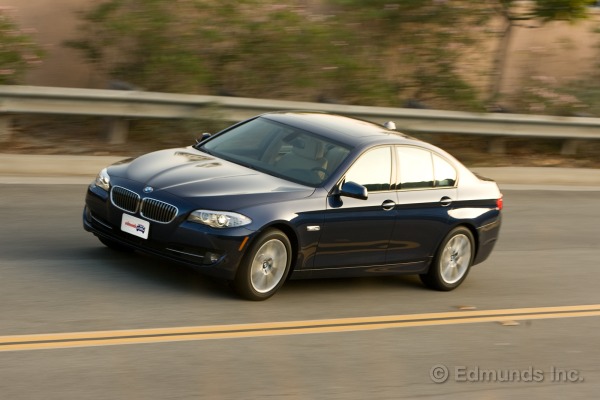
BMW's 5 Series is a benchmark midsize sedan for most luxury automakers, and a vehicle to aspire to for performance-oriented drivers as well as certain image-conscious consumers. So it's surprising that BMW wouldn't offer a branded premium audio system, particularly when most competitors have aligned themselves with high-end audio imprints.
As with every current 5 Series model, the best we could get in our long-term 2011 528i is the "Premium hi-fi system" that's part of the pricey $4,500 Premium Package 2. And while an impressive logo doesn't guarantee great audio performance and in some cases only serves as interior eye candy, the generic system in our 528i also doesn't come close to setting a benchmark in sound.
The Setup
The Premium hi-fi system in our 2011 BMW 528i consists of 16 speakers powered by 600 watts directed into nine channels. BMW couldn't provide exact speaker sizes, but the locations include a tweeter and midrange in the center of the dash, a tweeter in each "mirror triangle" in the front doors, a midrange in each front door, a tweeter and midrange in each rear door, another mid-tweet combo in the rear deck and two woofers underneath the front seats.
The Sound
As with every system I test, I listened to over a dozen musical tracks that I've heard in literally hundreds of vehicles to gauge clarity/lack of distortion, tonal balance, timbre, tonal accuracy, soundstaging, imaging and dynamics. I also used non-musical tracks to test soundstaging, imaging, linearity and absence of noise. For more details on this testing process and the tracks used, check out on the Edmunds.com article Sound Advice.
The 5 Series occupies the middle ground in the BMW lineup, above the traditional entry-level 3 Series (that's since been ceded to the 1 Series) but below the corner-office status of the 7 Series. Similarly, the performance of the 528i's Premium hi-fi system straddles the line between good and great — but never crossing into exceptional territory.
The system had sufficient clarity, with only a bit of the typical midbass distortion and thickness, which also skewed tonal balance. Timbre and tonal accuracy were above average, although I could clearly hear coloration on certain instruments. The system also lacked sufficient dynamics, so that drums, for example, didn't have the visceral impact that gives recorded music a lifelike quality. The woofers under the front seats couldn't muster butt-shaking low bass — but did induced a bit of annoying panel rattle on some of the deepest notes.
Soundstaging and imaging were a diffferent story. The stage extended beyond the 528i's sizeable dash, with left and right boundaries past the A pillars, and imaging was pinpoint accurate. The expansive soundstage and precise imaging worked in tandem to give the music a tangible sense of space and a layered quality.
In addition to music, I check soundstaging and imaging with two test tracks — one with voices mixed left, center and right and another with seven drum beats that are supposed to cross the dash at precise intervals. The BMW 528i's system easily passed both, and on my evaluation sheet next to the two checkboxes for the test I scribbled “Prefect.” Linearity, a measure of how well the sound holds together at low- and mid-volume levels, was also exceptional, with the system scoring good and excellent, respectively. It also nailed a zero-bits/absence-of-noise test.
One thing that sets this audio system apart from those of other automakers is it includes an old-school graphic equalizer, as opposed to only simple tone controls. The 7-band EQ can be used to tweak away some of the clarity issues and dial down the bass — or crank it up if that's your preference, sound quality be damned. But such signal processing won't do much to improve timbre and tonal accuracy if it doesn't already exist with the controls set flat, and it becomes the equivalent of an audio Band-Aid. The system also includes Dolby Pro Logic and surround processing, which expands the soundstage but adds an artificial quality to the sound.
The Sources
The dash contains a CD/DVD player, and Sirius satellite radio and an AM/FM tuner with HD Radio capability are also onboard. iPod integration is via a USB port and aux-in jack and requires a two-pronged cable that plugs into both. Once an iPod is plugged in, the user has to wrangle with the vehicle's iDrive center-console controller to get to their tunes.
While overall the iDrive interface has improved, the process for getting to a specific track on an iPod is still frustrating. As you can see in this video from another post, it takes up to five clicks of the iDrive interface to simply play the track you want, requiring a lot of eyes-off-the-road time. Plus, the iPod menu doesn't contain top-line categories for podcasts and audiobooks, which is becoming more common. You can also use a USB drive instead of an iPod, as many of our commenter often suggest. But you still have to deal with the same overly complicated menu structure.
What We Say
Although most of BMW's competitors have now hooked up with name-brand high-end audio companies, it's doubtful that most people will buy one car or the other in this class based solely on the stereo. But I would also bet that a large segment of BMW customers are hyper brand-aware and care about status if not sound. Too bad an exclusive with B&W is already taken.
But beyond audio branding, while BMW sets a benchmark in the luxury-sedan category with the 5 Series, the Premium hi-fi system in our long-term 528i simply doesn't measure up.
The Scores
Sound: B-
Sources: B
iPod Integration: C-
Cost: C